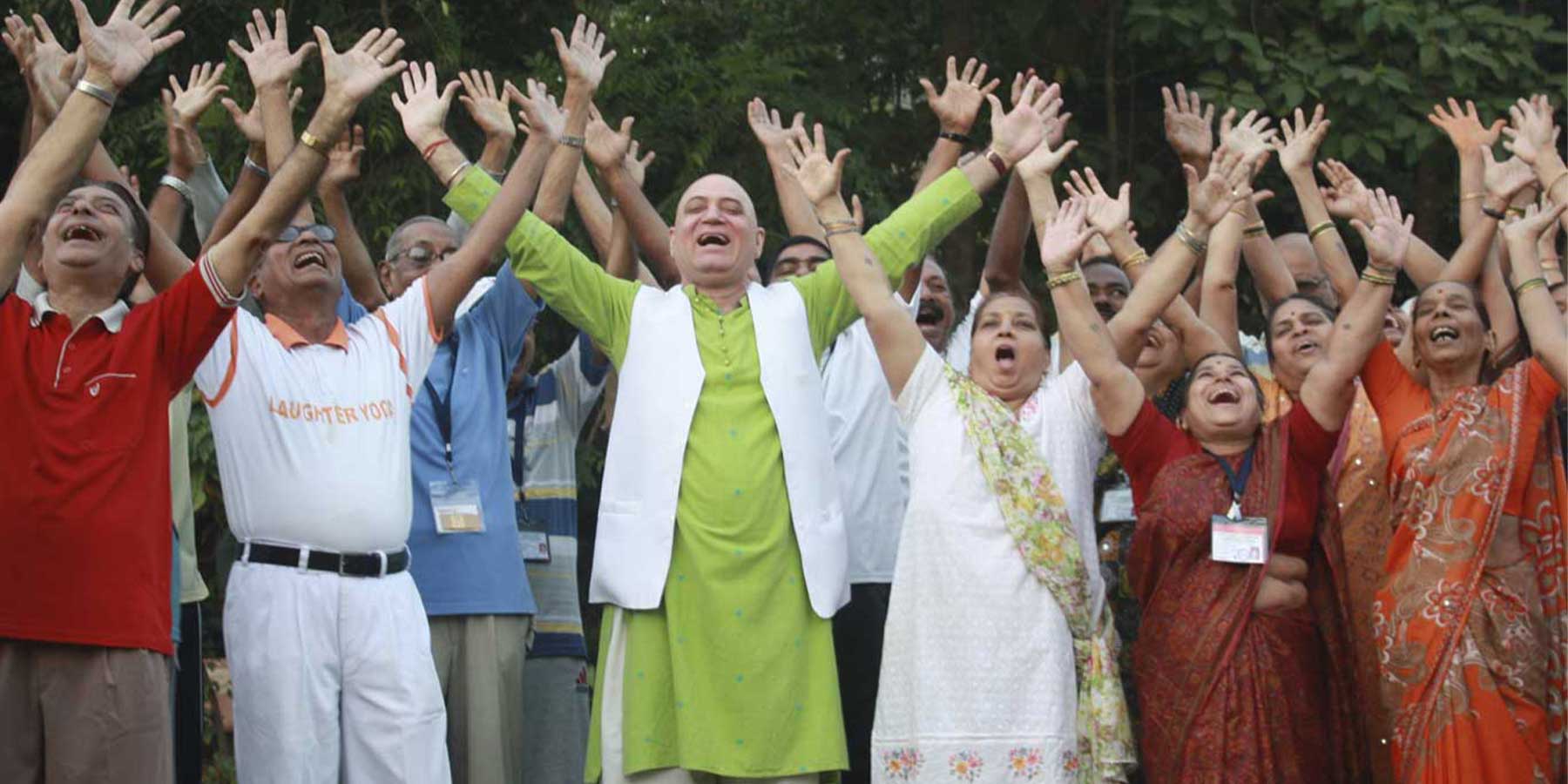Home » Interviews » Dr Madan Kataria Emphasises: Laughter Yoga Promotes Happiness, Mental & Physical Health, and Workforce Motivation
Interviews
Dr Madan Kataria Emphasises: Laughter Yoga Promotes Happiness, Mental & Physical Health, and Workforce Motivation
Published
1 year agoon
By
Huda
Laughing yoga, a UK-based practice, is a routine activity aimed at expelling negative energy and concerns while also freeing the body and mind from daily pain.
The profession of Facilitator of Happiness has historically and currently occupied a significant portion of the interests of the English personality. High prices, inflation, and crime rates have led to a decline in Britain’s standard of living, causing widespread stress, apprehension, and loss of familial cohesiveness. The British public must be aware of moral and psychological issues, in addition to rational solutions, to effectively address various issues.
There are still a lot of recreational and mental healing centres in British cities, but they need to improve their outreach and raise awareness of their present worth. Especially in light of recent research conducted in the United States of America and Bangalore, India, that has proved its viability and value in various settings and areas, including the corporate world, schools, hospitals, aged care centres, and other establishments.
Humour is crucial in coping with daily struggles and reminding British individuals to prioritise their mental, physical, and spiritual well-being while sharing their sense of humour with others.
Arabisk London had a conversation with Doctor Madan Kataria, also known as “The Teacher of Laughs,” the pioneer of Indian laughter yoga, the leader of the laughter yoga clubs movement, and a corporate advisor for comprehensive health and communication skills for domestic and international businesses throughout India, USA, Canada, Europe, Switzerland, Australia, Singapore, and Dubai.
Arabisk explored the efficacy of laughter yoga techniques in reducing daily anxieties and enhancing resilience, while also highlighting the need for a supportive work environment. This is one of the several different elements that make up this conversation.
Interviewed by: Mohsen Hassan
Firstly, Dr Kataria, how did yoga contribute to the development of the functional idea of laughing, and how much of an influence did the outcomes have?
In the past, people practised yoga without laughing, and conventional concepts of humour shaped attempts to make a connection between the two, even in the earliest attempts.
The situation is quite different now. With deliberate laughing combined with the practice of yoga, laughter yoga has become a complete and well-liked approach to well-being. As a result, we have moved tradition and are now concentrating on harnessing the therapeutic benefits of laughter to improve mental and physical health.
We are also reaping the rewards of the novel marriage of yoga and laughter, which strengthens social ties and makes it easier for people to discover happy and unusual paths to well-being and balance.
You are credited with establishing the laughing notion in yoga. How did it begin?
Towards the end of the 1990s, my specialised practices and readings on yoga and laughter led me to the realisation of a fundamental fact: intentional laughter contains far more moral and health stimulants than spontaneous laughter, and it has been proven by research and study to have a profound effect on the neurotransmitters that dominate a person’s mood.
There were only five members when I started the first Laugh Yoga club in a Mumbai public park in 1995. We used to rely on telling funny jokes until we ran out of them. When certain members refused to engage in vulgar jokes, finding a clear method that would not make people laugh was essential, allowing the club’s activities to continue without being closed.
The human body is incapable of telling the difference between phoney laughter and real, spontaneous laughing, as I learned when I encountered the term “fake humour” in one of my readings. As a result, it is possible to reap the same benefits from the former as from the latter, if one engages in forced laughter deliberately and intelligently.
Then, after using this laughter method on the participants as well as on a few of my patients, it spread online and to a large number of people participating in laughter yoga sessions. As a result, over 16,000 clubs across more than 100 countries worldwide have formed a global movement for laughing yoga.
Does Laughter Yoga offer a wide range of foundations and methods?
Indeed, without a doubt. Laughing yoga is based on many fundamental concepts, one of which is the practice of artificial or purposeful laughing that is independent of jokes, humour, or obvious logical explanations—that is, laughter without cause. The approach here usually starts with some simple group exercises and enjoyable activities.
Another idea is to bring back memories of childhood and its carefree and enjoyable environment. In other words, Laughter yoga encourages participants to let go of the aggressive, serious framework and customary seriousness. Instead, they are encouraged to laugh and play like children. This promotes reciprocal laughing among participants while also freeing them from the usual framing of their egos and selves.
Laughter Yoga methods use group activity dynamics and eye contact as fundamental components. This kind of yoga is typically done in groups. As a result, participants experience their joyous inclusion and the full beneficial effects of the laughing exercise. Additionally, one of the key components of this healing-focused kind of yoga is the ancient practice of fusing laughter with deep breathing.
What are the practical procedures that someone may follow to do laughing yoga?
Laughter yoga has three primary blended elements: engaging in fun, practising breathing methods, and using fake laughing. Finding a peaceful, cosy area with unrestricted movement is the first step for anyone looking to begin laughing yoga exercises in or out of the house. Then, perform mild workouts that include blood circulation stimulation and muscular elongation as a prerequisite to warm up and ready the body for activities involving fake laughing.
After that, there’s a phase where you create a happy environment by clapping and laughing aloud repeatedly, like “hoho/haha.” You can also practise multiple breathing techniques and a series of laughing exercises by inhaling through your nose and exhaling slowly through your mouth, which helps to expand your diaphragm and put your body in a relaxed state that helps you achieve balance.
It is usually advised to take a comfortable seat, close your eyes, and concentrate on remembering the happy times and emotions that made you laugh. This helps to enhance the meditative qualities of laughter yoga. Naturally, these actions are combined with lighthearted, enjoyable pursuits meant to elicit genuine laughter.
What is the best way to conclude laughter yoga sessions once the preceding stages have been taken?
Once you’ve engaged in enjoyable activities like role-playing games and pretending to be animals or other characters, you may go into a relaxing stage when you gradually reduce the volume of your laughing and execute moderate yoga poses to help your body rest again.
Group laughing yoga sessions typically conclude with participants standing in a circle and holding hands. Moments of mutual laughing ensue after this to strengthen the sense of community and oneness. Finally, the group returns to the final stage, known as the (reflection) stage, where each participant acknowledges the degree of the positive change in their overall psychological, emotional, and mental condition; in their mood and sentiments.
Is laughing yoga beneficial in countries like British society, which are rife with production worries and job pressure?
As previously said, the primary goal of laughing yoga is to improve physical, mental, and emotional health rather than just amusement. This is because the practice leverages the therapeutic powers of laughter to improve overall well-being. This has amazing benefits in many work settings and considerably aids in preparing workers, employees, and all technical and administrative components to produce more.
This suggests that the benefits of laughing yoga may play a creative role in offering non-conventional answers to problems related to life and the economy that can affect any civilisation on the earth, not just British society.
Regarding the function laughing yoga plays in the workplace, the economy, and daily life. Which innovative applications are the most significant ones for it?
The concepts and practices of laughing yoga are incredibly diverse, as I have already discussed. On top of that, the concept of “corporate laughter yoga” has emerged in the professional and employment spheres in recent times. Worldwide, there is a growing trend of businesses setting aside controlled and researched times for their staff to engage in laughing exercises as a way to improve their moral and mental well-being.
This is a result of multiple studies—conducted by these organisations as well as others—that show laughter lowers stress, strengthens team dynamics, increases creativity, and generally, helps to provide an excellent and nontraditional instrument that works well for team building, encouraging a happy work atmosphere that can accommodate its human aspects and workforce, and spreading the sense of collective spirit.
Do you think that the therapeutic benefits of laughing yoga may successfully help reduce the financial burden of health-related issues for workers in organisations and corporations?
To begin with, it is important to note that laughing yoga is not a therapeutic substitute for conventional, organic medicine. Nobody expressed that. Laughter yoga is a supplementary therapy for a range of illnesses, and it occurs under the supervision of medical professionals. However, it is usually possible to stress the financial gain of assisting companies and organisations in avoiding having to pay for medical care.
Laughing helps the body fight illnesses by boosting immune cells and producing neuropeptides that fortify the immune system which helps the body fight diseases. It also reduces pain and relieves waves of anxiety, depression and tension inside and outside the work environment.
Laughter produces endorphins and feel-good chemicals like dopamine and serotonin. At the same time, it inhibits stress hormones such as cortisol and oxygenates the body via breathing methods, raising energy levels, alertness, and contributing to overall respiratory system health. Undoubtedly, all of this comes with a financial cost, and laughing yoga relieves those costs for businesses and organisations by offering cost-effective, easy-to-use, and inspiring entertainment programmes that boost output.
The powerful physiological and psychological effects of laughter yoga have recently come to light thanks to scientific research. By stimulating the brain’s lobes, laughter yoga improves cognitive functions in workers, employees, and managers. This improves intellectual capacity, problem-solving abilities, and general mental clarity. These all-encompassing advantages have made it possible for Laughing Yoga must be part of standard medical methods.
Considering the aforementioned general advantages of Laughter Yoga, what specific needs exist for working-class communities?
Members of the working system should include laughter yoga into their everyday routines, either individually or through group sessions. Indeed, we urgently need to generalise this integration not only in the workplace but in every social sector, regardless of size or kind, as we are modern societies beset by numerous challenges at all levels.
More than ever, societies must help people develop more positive outlooks on life, which are attainable through the emotional flexibility that laughter yoga provides. This flexibility frequently results in a comprehensive improvement in the quality of life by combining physical, mental, and social benefits.
This is because we are facing a comprehensive approach to well-being that goes beyond the material aspects to what is deeper and more beneficial, offering moral solutions that are frequently lacking among various societal segments and stages. Generally speaking, we must understand that laughing yoga is practically risk-free and that it can be specific to any area of life, both virtually and physically, through online resources.
Which kind of laughing yoga—group or individual—is more advantageous and successful?
Individual and group laughing yoga practices yield the same benefits, but as I previously stated, group laughing yoga is the best way to fully reap the benefits of the practice, as group sessions foster a stronger sense of community, shared laughter, and social communication.
Additionally, it subtly resolves a great deal of the social and psychological complexity that each member of the group possesses. Group laughing yoga, for example, addresses shyness, hesitancy, and social anxiety while also assisting introverts to interact and integrate socially.
It also promotes reconciliation among members of society, removing animosities and deepening friendships. This, as well as its overall positive impact, is only possible through group involvement rather than individual participation. These sessions, which normally last between thirty and sixty minutes, are appropriate for the great majority of age groups.
Do online Laughter Yoga classes have the same momentum as in-person sessions?
There are subtle distinctions, and while direct and field sessions have more effect and provide better results, this does not preclude virtual sessions from being very positive.
This is what I’ve discovered based on the participants’ comments and the evident influence the sessions had on them. My most recent session, for example, with the medical staff in the Oncology Department at the University of San Francisco, which took place over the Zoom programme and lasted approximately a quarter of an hour, had a very positive impact, to the point where the staff members expressed a strong desire for the session to last longer. This is a positive sign.
Lastly, and in all honesty, how has laughing yoga affected you personally? If so, please share your experience and the outcome.
I did, and I performed it often. Since laughter yoga entered my life two decades ago, I have followed a daily schedule that starts at four in the morning, when I practice it for at least thirty minutes. Then, I repeat the practice throughout the day using social media and other means.
I discovered that this regular, recurrent programme had a profoundly favourable effect on every aspect of my life, both material and moral. My immunity has increased, and the disease left me after attacking me several times in a year, and all of my negative concepts and impressions about people and life had transformed into a comprehensive positive image as a result of my frequent laughing behaviour, which allowed me to be generous in giving, achieving, and receiving love and affection from everyone.
Furthermore, it also left me with a persistent sense of fulfilment and happiness, as well as an intense desire to help or enable the achievement of others.
Read more: Narah Saad, a Saudi Visual Artist, told “Arabisk London”: I believe there is life in art
You may like

Adeem Al-Fursan: A Novel Development Project in Riyadh

Ahmed Reyad, an Egyptian Face-Reading Expert: Personality Analysis Inspires Self-Improvement and Societal Change!

Saudi Arabia’s Cold Tourism in 2025

Humain, an AI Startup, is Launched in Saudi Arabia

Saudi Arabia Addresses Overfishing

